We’ve been intending to post this ever since our last day in Amsterdam. Life just became too busy….
How did your bike work out? Any major breakdowns?
Selecting a bike for a ride like this may be the most important decision you make. For us, our decision was perfect. We loved being on a recumbent and we loved being on a tandem. We were amazed at how well we could converse, and riding a tandem made the trip feel more like a team effort than if we had ridden independent bikes.
We have nothing but praise for Nazca Ligfietsen. The bike was solid the entire trip. As a bonus, Monique, the co-owner of Nazca Ligfietsen, remained in contact with us through much of our trip ensuring everything was going smoothly. Her customer engagement is exceptional. Occasionally we still exchange email and I always look forward to her responses.
The decision to use a Rohloff hub for our drive train worked out nicely as well. It is solid. Over 3 weeks we experienced no issues. Normally, the drivetrain would be the prime target for a tour-impacting failure. We felt comfortable and confident with the Rohloff. We probably made a mistake by swapping the rear sprocket from a 16-tooth to a 13-tooth sprocket. As we prepared for our trip we found we wanted more top-end speed when riding the bike without panniers. However, once it was loaded down riding above 20 mph was rarely a concern. We needed the lower gearing for the hills and missed it sorely. Literally. I found the spacing of the gears too close on the Rohloff especially in the lower range. The Rohloff evenly spaces the gears, so each shift up was a 13.6% increase in the gear ratio. The even spacing is one of their selling points. However, I found that in the low gears we could often skip a gear when moving into or out of a hill. While the spacing felt right on the high end, for me, the ideal spacing would be several percent higher. I don’t think the experience would be as good in the higher gears, as that is where the spacing feels right if not too abrupt – but I’d be willing to trade that for a broader total range.
The most likely breakdown would have been a flat tire. Our bike was equipped with Schwalbe Marathon Plus tires. We were confident enough with these tires that we elected to not bring any spare tires with us. We brought a pump, a tube patch kit, and a tire patch kit, but we never needed any of them. For the most part the roads were free of debris and the few times we hit something in the road the Schwalbe tires were able to resist a puncture. And while we were prepared to deal with a flat, having one would have cost a lot of time – especially if the flat were on the back tire, as we would have had to unload the rear of the bike before attempting to fix the tire.
When we first received the bike I was a little disappointed by its weight. The steel frame is heavy. The Rohloff hub is heavy. Even the tires are heavy. The bike weighs in at almost 90 pounds and we added about 60 pounds of food and gear. However, the bike’s heft evokes confidence. As we’d find ourselves off the beaten path far away from civilization, in high grass, on single tracks, or on rocky roads, we rode without worrying about the bike breaking down. There were several places where a breakdown would have cost us dearly. It was nice to ride without any stress or concern for our bike.
If you are going to do a big bike tour, get a good bike.
How did you plan your route?
We planned our trip around 3 destinations: make it to Bastogne by June 26th for Natalie’s 50th birthday, make it to Paris by the next Sunday so we could attend church, and make it to Antwerp by the following Sunday so we could attend church again. Other than those and making it back to Amsterdam in time to fly home, we had a blank slate.
We started by figuring out about what our daily range was. We planned several multi-day rides near our home in Utah to get a feel for how far we could go in a single day with our gear. We tried to select routes that had similar hill profiles to what we expected in Europe. After several rides decided to target about 65 miles per day. We could ride a little further if there were few hills and a little less if there were many.
We used Komoot for planning the actual roads and trails we would ride on. We used Komoot for our shake-down rides near our home as well, learning some of its nuances. The software was good at putting us on roads and paths friendly to bikes, but it didn’t seem to care about hills. We cared a lot about hills, so at times we would insert additional waypoints between a start and stop location in an effort to pull the route around a hill. For the most part it worked, but occasionally we would fail. On our way to Bastogne we were on the beautiful Ravel bike trail – a converted railroad line with minimal grades. Komoot took us off the Ravel to save a few miles, but in exchange for the shorter distance we had several painful hills. In hindsight we would have gladly exchanged the savings in distance for a better hill profile.
Komoot offered us a few choices for biking style – road biking which tended to keep us on roads and tour biking which tended to keep us on bike trails and bike paths. We needed a setting in-between, as the tour biking paths tended to put us on dirt roads and single track trails while the road-biking kept us on larger and more-busy roads. Each night I would spend time on my phone reviewing the next day’s route, comparing the road-biking option to the tour-biking option and modifying each until I found the right compromise. Once set, I could upload the route to our bike computer (a wahoo elemnt bolt) which would allow me to have an electronic map at the front of the bike and Natalie to have an electronic map on the phone attached to the back of my seat. Navigation, especially in the larger towns, required both of us to be working together. In many ways, working together to navigate was one of the fun experiences of the trip, as it forced us to use teamwork.
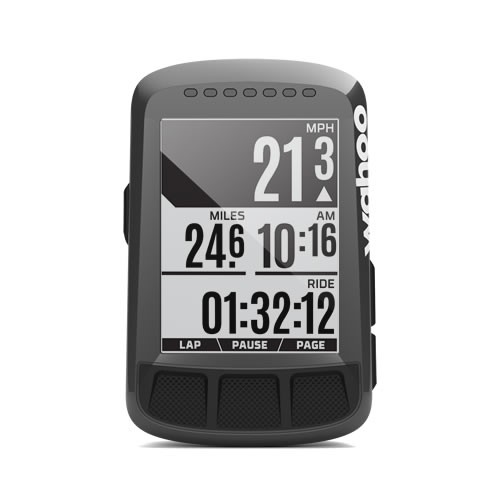 Our trusty bike computer
Our trusty bike computer
One day we tried to use the bike route favored by Google maps. We quickly decided that Komoot had a better feel for the roads and paths in Europe.
How did you plan your nightly accommodations?
Using the route set by Komoot and our riding-range estimates, we preplanned all of our hotels, bed and breakfasts, and Airbnbs. Originally, I was favoring hotels. I’d figure out roughly where we would want to spend the night and then send emails to all of the hotels in the area trying to find one that could securely store our bike. Using this approach I was able to make a bunch of reservations over a period of a few weeks. But then our plans needed to change for one reason or another, and so I’d have to start the process over again after canceling our hotel reservations. This was somewhat of a hassle. I identified several normal bed and breakfasts which seemed to offer nicer accommodations and more often could deal with our bike – but the pattern recurred and it felt much more personal to cancel our reservations with these smaller operations. In both cases, we struggled with a lack of options for the smaller towns. While there are likely hotels in all of them, most were not available on the internet.
Enter Airbnb. During one of our preparation rides in Utah we decided to give Airbnb a try. Natalie was a little nervous – as we would be staying in someone’s normal home. It just seemed weird. On that ride we stayed 3 nights in Airbnbs and loved it. In one case we had the whole house to ourselves and in the other case we stayed with the family (two nights – one before our ride and one after). We used Airbnb on our next preparation ride in Utah and had another good experience – we were hooked. Airbnb helped us in five ways. First, where we were riding in Europe there were far more Airbnbs than hotels we could find on the internet. The Airbnb interface made it easy to look at a map overlaid on our route and see all the possibilities. The second thing Airbnb did was made it very easy to communicate with the hosts. For the hotels I’d have to search around for email contact information – with Airbnb it was built in. Third, Airbnb did a great job of keeping track of all of our accommodations and adding them to our Google calendar and automatically guiding us in when we were riding into a town where we would be staying. Fourth, Airbnb homes in Europe were most often much less than hotels. Even homes where we would have the entire home to ourselves with a full kitchen and laundry facilities would be less than a hotel – sometimes half the cost. And finally, using Airbnb all of the payment for our accommodations happened in the application. With hotels we could use our credit cards, which wasn’t a big deal. But with the normal bed and breakfasts we’d have to remit payment either in cash or via bank transfer. We became big fans of Airbnb. We still had a challenge with responding to the need to change our route as Airbnb only allows you to cancel three reservations a year before they start charging you their booking fee even if you cancel. This is a pretty painful policy for someone on a bike tour with a lot of variables which can impact your itinerary.
In every case, although to varying degrees, the Airbnb and normal bed and breakfast hosts were delightful. Getting to interact with our hosts was something we looked forward to. I still feel bad for the few we had to cancel, as it seems like we violated the trust of a friend.
We’ve wondered if it would be a better experience to not pre-plan any of the accommodations. This would give us the freedom to dynamically change our tour based on weather and scenery. We would have loved to add a day to Berck so we could spend a day at the beach. Toward the end of our ride we were feeling strong and probably would have added a few miles to each of the rides. In a few of the towns we might have chosen to ride past them as they were a little too busy for our taste. Not having reservations for the whole trip would free us of the stress of a schedule but it would replace that with the stress of not knowing where or if we would find accommodations. Airbnb might not work as well in this scenario – it would need to have a “last-minute” mode which provided a more rapid back and forth conversation with the hosts (however, in most cases they responded within hours of posting a question).
How did you pack?
For clothing we each took 4 “kits” with each kit being made up of bike shorts, bike shirt, and socks. We also took one set of clothes that would work for nicer venues such as church and one set of clothes that would work for casual sight-seeing. (We were definitely not going to walk around town in our bike shorts – we already looked like goofy Americans on our bike – it would make no sense to further abuse the better taste of those around us by walking around in spandex.) I managed to find a single pair of pants that would work for both, so I was able to lighten my load slightly. We each had 4 pair of underwear…. Needless to say, we were dependent on finding laundromats along the way.
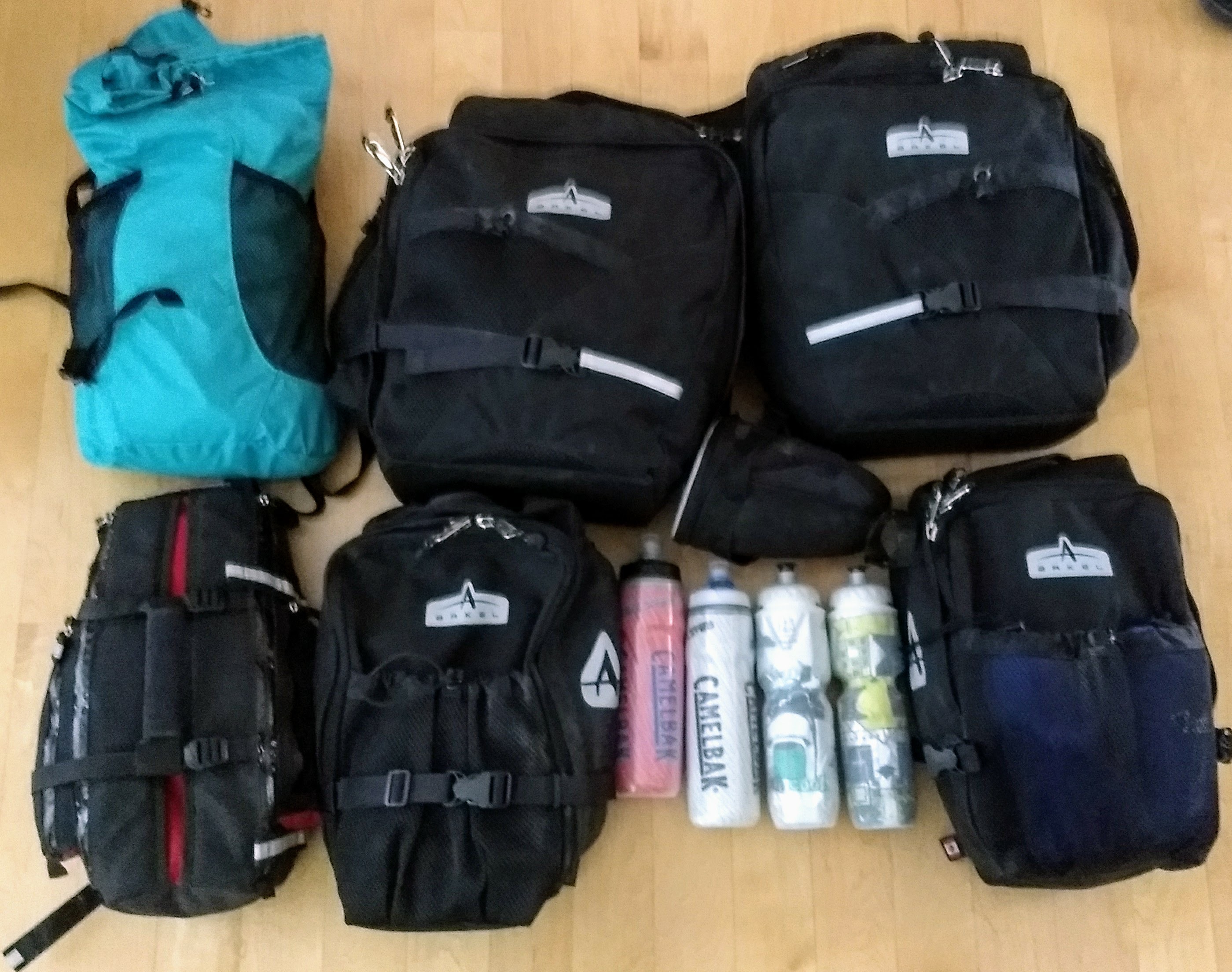 This is everything we took for 3 weeks.
This is everything we took for 3 weeks.
We each had two panniers – one larger one and one a little bit smaller. We bought our panniers from Arkel (T-42 and T-28 classic touring panniers.) I had previously bought some recumbent specific panniers from Arkel but after a few uses it was clear they were designed for a slightly different bike than ours. Arkel was super-good to work with and allowed me to return these even though it was far past the returnable date.
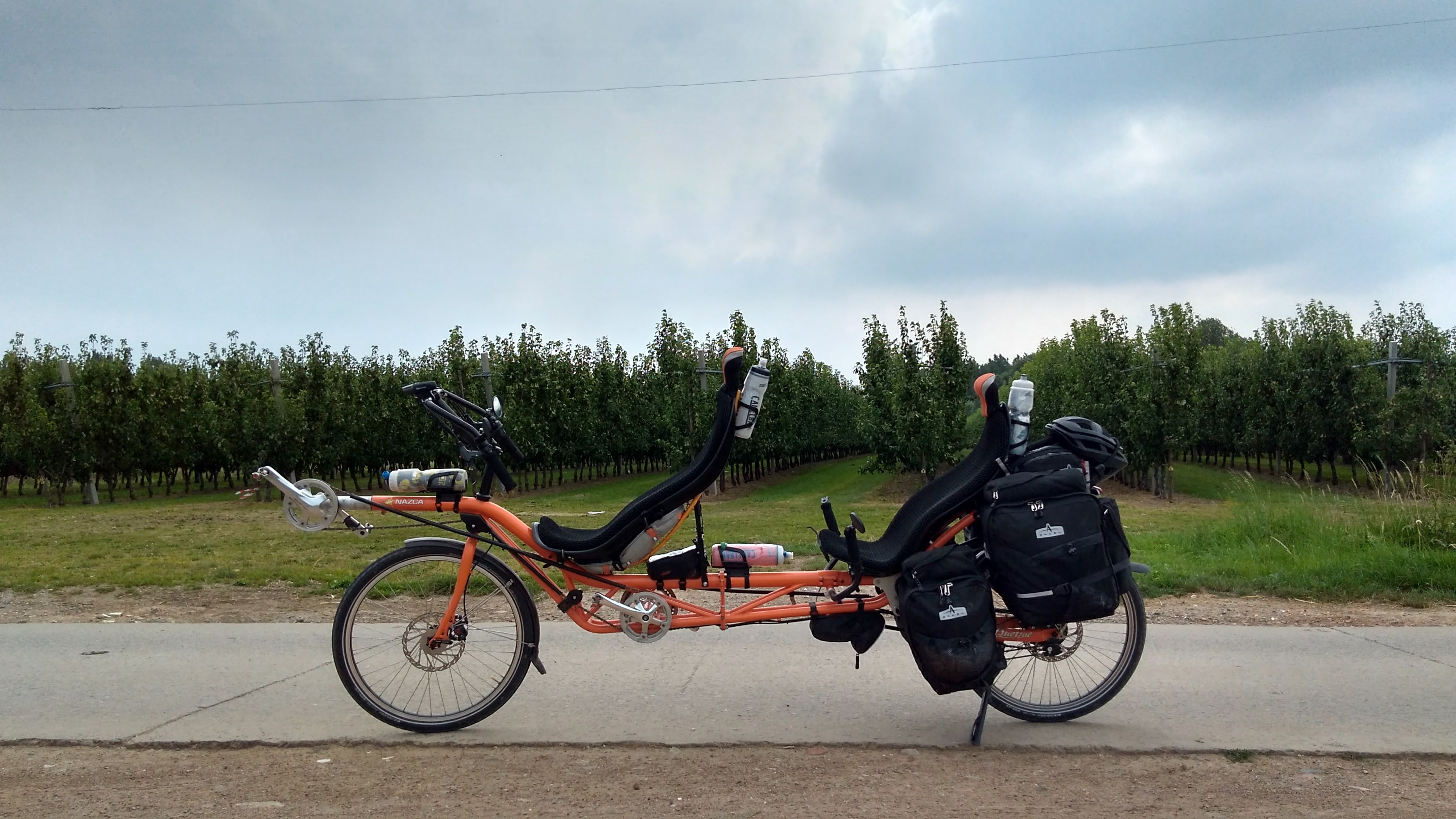 Bike with panniers
Bike with panniers
I’m grateful for their outstanding customer service and would highly recommend them – but I wish I had selected waterproof bags. We carried rain covers for our bags which simply added bulk to our already tight storage and required us to stop when the rain would come. Even with the covers, our massive downpour going into Paris was enough to dampen the interior of our panniers from the wheel-facing side which wasn’t covered by the rain covers. If we could do it over we would chose the Orca or Dolphin panniers. Next to the bike, these are the biggest gear investment. It is worth getting it right.
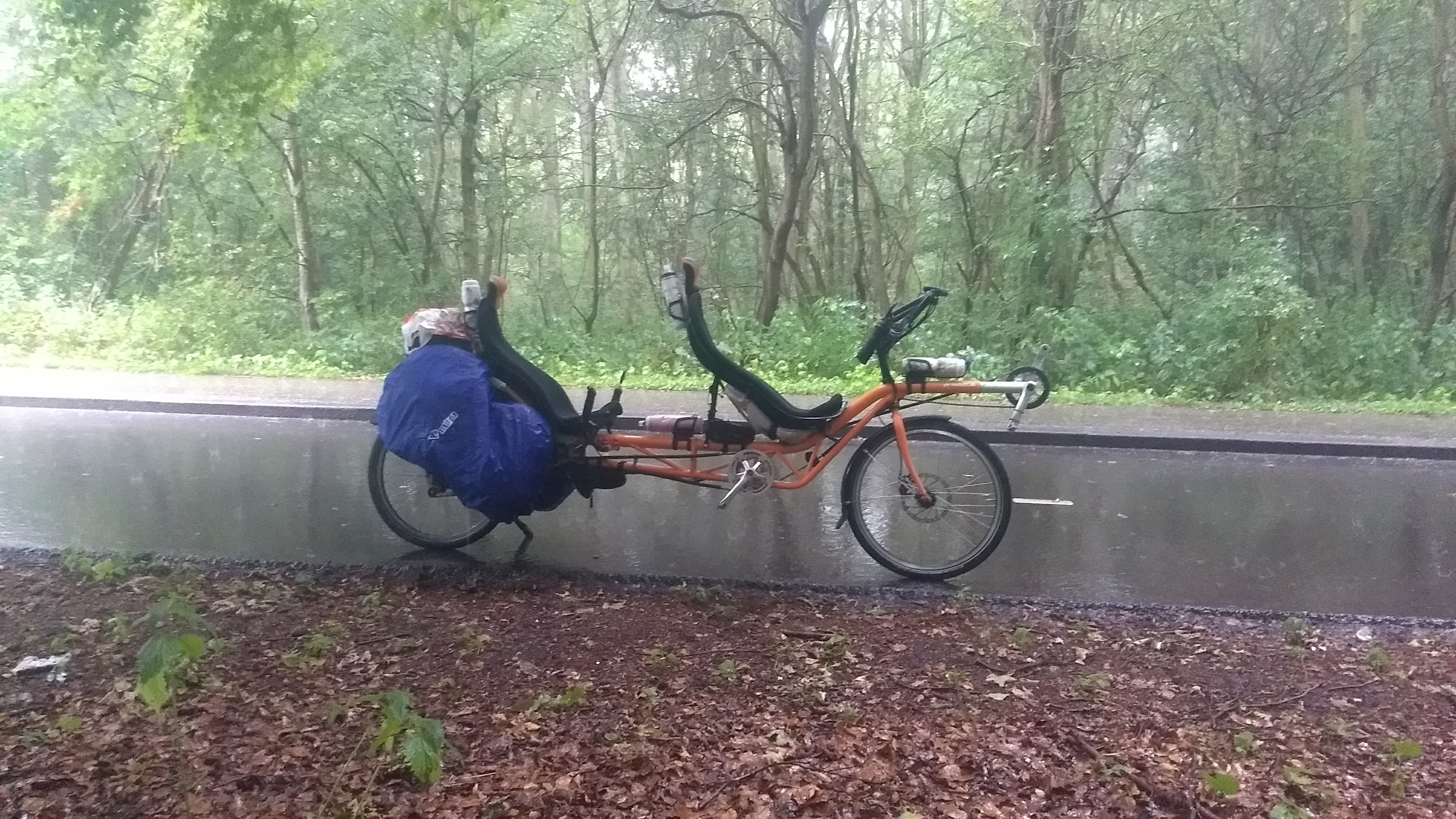 Panniers and rain covers
Panniers and rain covers
Inside our panniers we used Amazon-basics packing cubes. These were super useful for keeping our gear organized. They allowed us to completely unpack our panniers each night and repack them in the morning without creating a complete mess. Both of us used one cube per kit (which fit perfectly). In the evenings we’d change into our casual clothes, take out the next day’s kit, and put our dirty bike clothes into the cube we had just emptied. It was easy and efficient. 8 cubes fit perfectly into our large pannier. Each of our smaller panniers was used for miscellaneous items such as our casual shoes, coats, emergency bivy sacks, toilet paper, sunscreen, etc. Send me a note if you are interested in our complete packing list.
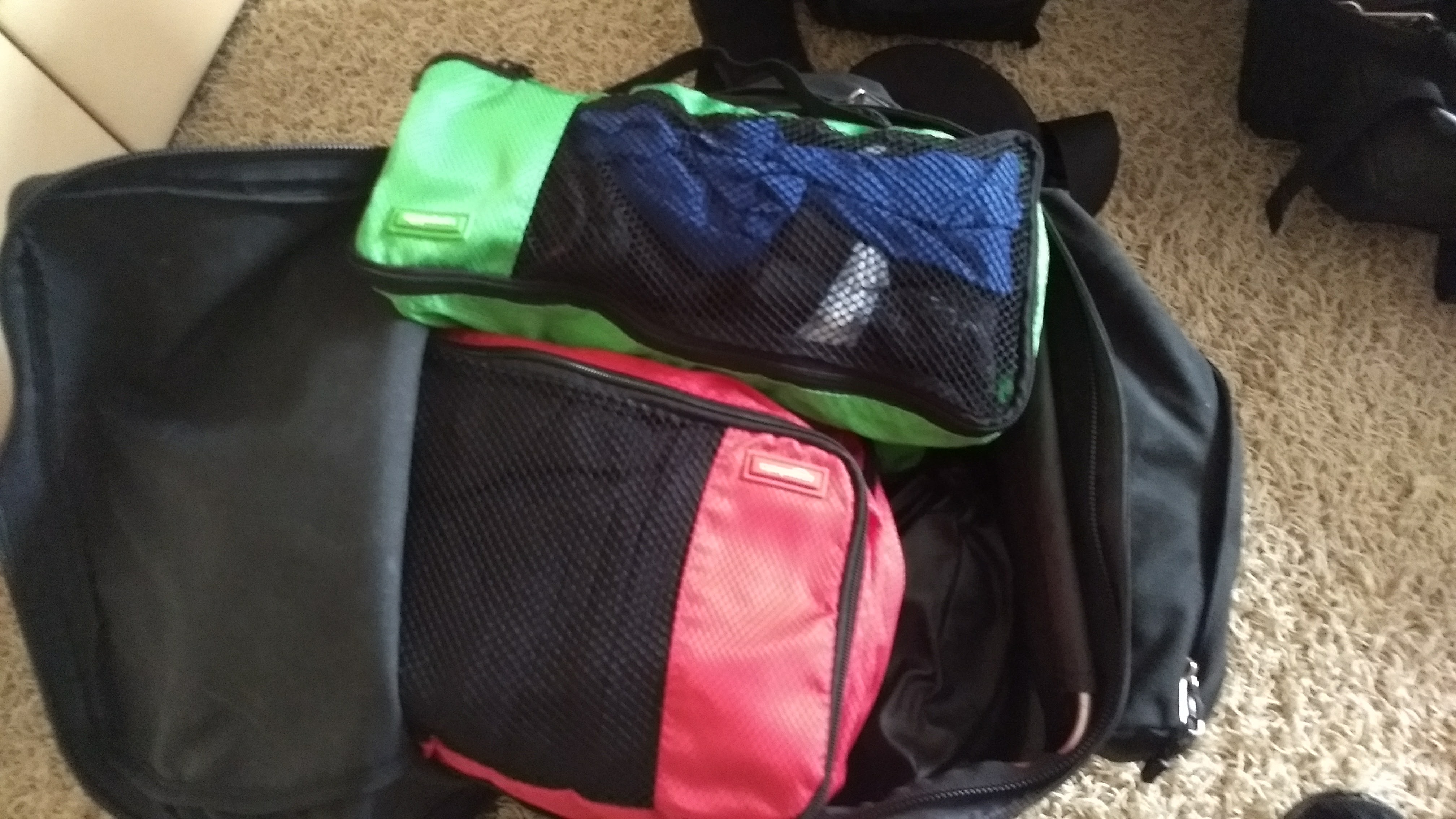 Amazon Basics packing cubes
Amazon Basics packing cubes
We’d do laundry about every four or five days. We’d always do it on a sightseeing day. Finding laundromats wasn’t a problem. We’d use the largest washer they had and wash everything possible all at once. I had brought a swimming suit (which I never used for swimming) which I would wear on laundry runs, allowing me to wash everything but the swimming suit and one shirt. I looked silly but it didn’t matter. Several of our Airbnb accommodations made a washer and dryer available, which we always took advantage of. In Europe, however, a “dryer” means a rack on which you can hang your clothes (except in the laundromats, where they had real dryers). Luckily these opportunities generally coincided with the sight-seeing days so we’d have extra time for the clothes to air-dry and most of our bike clothing was fast drying anyway. We had a little laundry line with clips that we could use to hang up our clothes in our room.
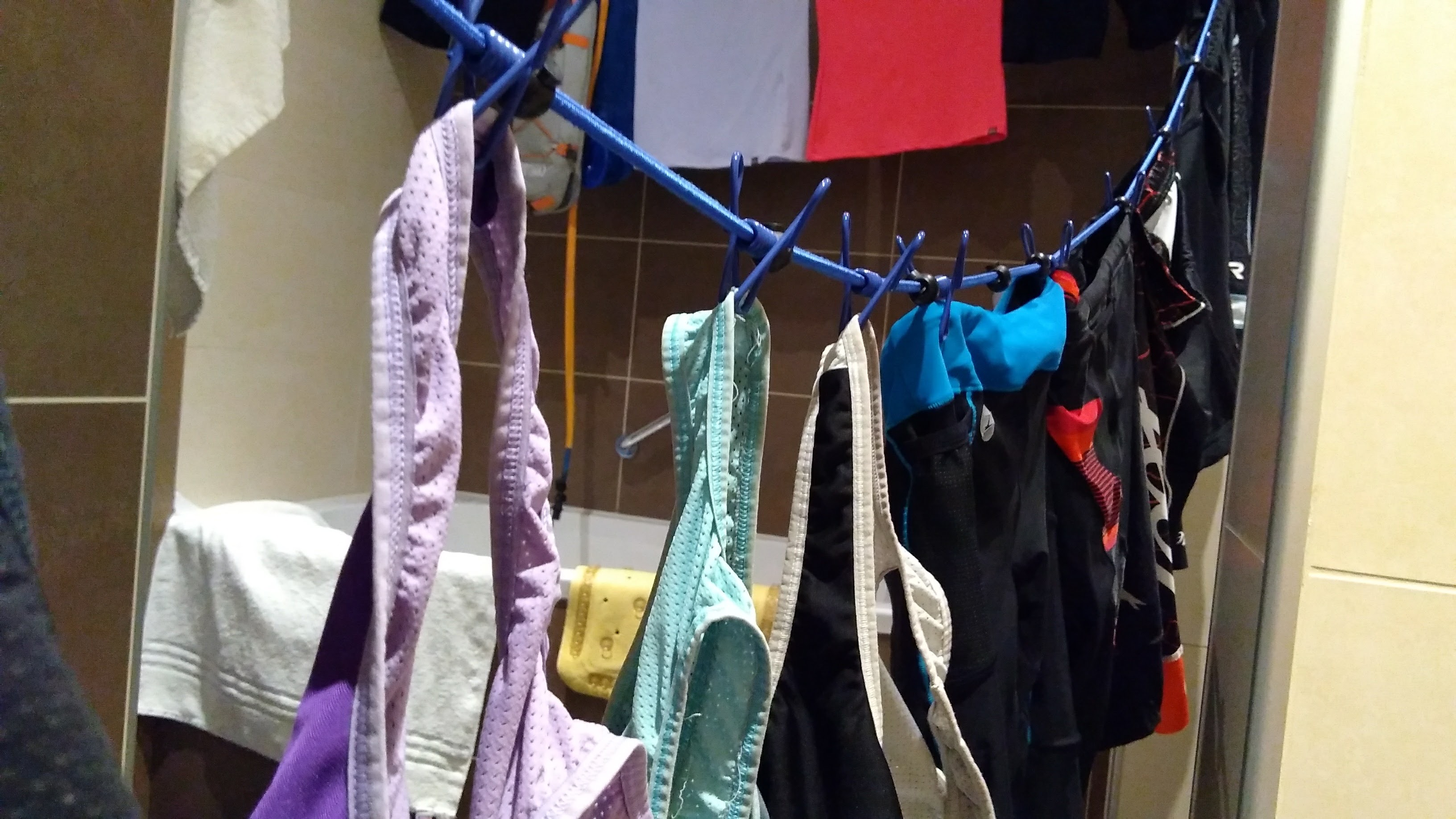 Clothes drying on our clothes line in our bathroom
Clothes drying on our clothes line in our bathroom
How did you handle eating? What about your vegan diet?
We knew going into this that we were going to have to be flexible with our diet. We didn’t ask about ingredients in things like bread and just ate them. When we had the chance to communicate with our host ahead of time we’d try to explain our diet, but often the language barrier confused people. We confuse people in English, so no surprise it was extra hard in non-native languages. When people would go out of their way to offer us something we would go out of our way to eat whatever it was. For the most part our eating entailed the following:
- Breakfast – if our hotel/B&B/Airbnb provided breakfast we’d eat most of the vegan options provided. We would often have breakfast snacks (fruit, breakfast bars, etc.) that we carried with us on our bike from town to town, and sometimes those made up a portion of our morning calories.
- Snacks on the bike – we had the trunk bag on the back rack of our bike which was dedicated to food and tried to keep it always full of snacks and fruit. We ate a lot of nuts – especially cashews we’d buy at Carrefour markets. Apples held up well, so there was always at least one or two apples in the trunk and sometimes an orange. Nectarines and peaches were on, but less durable – so when we bought them during our evening grocery run we’d eat them for dinner and breakfast. If one made it in the trunk it was often eaten before mid-day.
- Lunch – lunch was usually just a larger version of our normal snacks on the bike. We didn’t have a set time for lunch and we’d usually take lunch when we needed a slightly larger break. Although we didn’t purposefully avoid it, I don’t recall ever going into a restaurant for lunch. Lunch was generally on the side of the road somewhere except on our sightseeing days.
- Dinner – dinner was almost always accomplished by going shopping at a grocery store (more often Carrefour) when buying supplies for the next day. Many of our Airbnb accommodations provided us with the full house which included use of the kitchen. We would often buy a bag of salad, salad dressing (sometimes we’d carry some in our “fridge” between towns), and fruit. Several times we cooked pasta (our favorite was gnocchi) and pasta sauce. Occasionally we’d eat out, but I (Pete) was often too cheap to enjoy this. Because of our restricted diet, eating out often meant overpaying for a salad. Probably the best dinner was in Guignicourt with Jean-Réné and Nadya. We cooked a pasta dinner together with fresh vegetables and enjoyed a fun evening eating and talking at an outdoor table overlooking their farm and orchard. It was delightful.
- Hydration – we rode with 4 water bottles and one camelback and never ran out of stuff to drink. I was surprised that they didn’t have Gatorade, Powerade, or other sports drinks, which was probably for the better. We’d often buy one or two quart-size cartons of orange juice or mixed fruit juice on our evening shopping runs and have that at dinner and at breakfast. A few times we found almond milk – but it was always more than we needed for a single breakfast, so we’d use one of our water bottles to carry it between towns making it last for an extra day. We found one great use for our Camelbak – because it was full of water it was slightly cooler than the ambient air, so we would store a chocolate bar between the bladder and the sleeve. We called this our “fridge.” We didn’t have problems with melting chocolate.
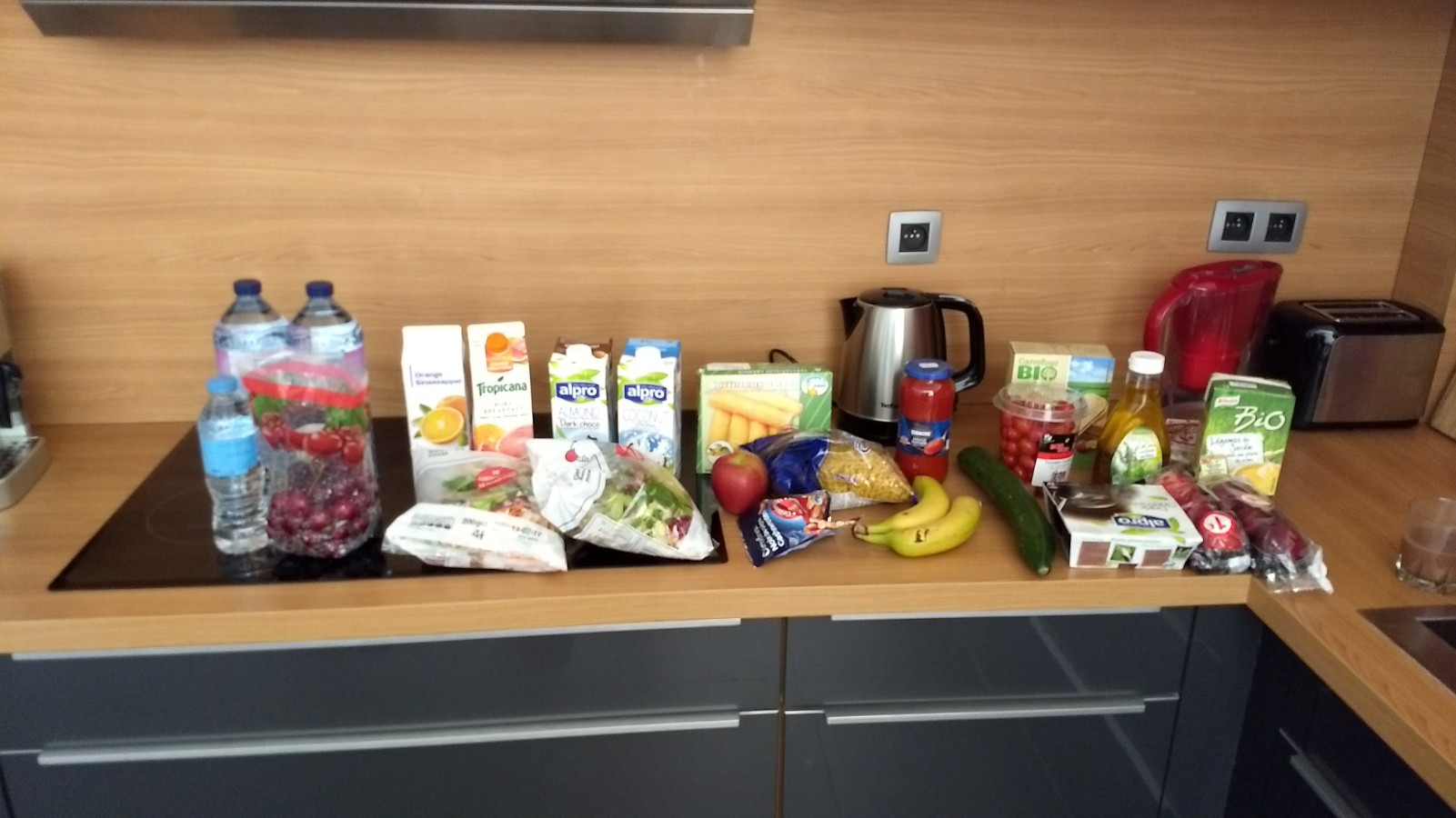
How did those fancy Patagonia Houdini coats and pants work out?
We paid a premium for these coats and pants because they were super light and super waterproof. It turns out they are only super light. On our ride to Paris we were both soaked to the skin. A few other days, in extended light rain, we were also soaked all the way through. In fairness to Patagonia, these are really light weight. Assuming they’d be fully waterproof was probably unrealistic. As we start gearing up for our next big ride we’ll be replacing the Houdinis with something else. A special kind of cheap indeed.
What was your favorite part of the trip?
We liked the whole thing – it is hard to pick a favorite thing, but if we had to identify the single best part of the trip it was simply being together. Sometimes people would jokingly ask us if we still liked each other after being together so much. Some would jokingly ask if our marriage could handle it. We laughed with them, as this was going to be the most time we’ve ever spent with each other. In the end we are pleased to report that the experience brought us together in a powerful way. This is probably the result of spending so much time together and having to work together both on navigating and powering our bike. The tandem helped a lot, as it kept us close and created the situation where we needed to work together. We had some funny friends who named their tandem “the divorce machine.” We would need to name ours the opposite.